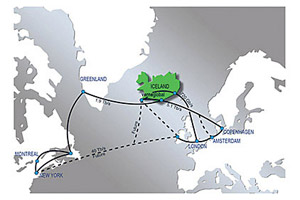The standard approach is to look for a site that offers cheap electricity since electricity is key for the big expenses of power and cooling. Locating in an area with hydroelectric power is prudent since hydroelectric is among the cheapest power. Microsoft and Yahoo went this route in Quincy, WA, and put their data centers there. A company that is particularly creative might even build a data center where there is cool weather. Yahoo went this route when it built its chicken coop data centers in Lockport, NY, to take advantage of hydroelectric power from Niagara Falls, and to take advantage of passive cooling through innovative design that took advantage of the cool climate and strong winds.
These are good approaches to saving money on power and cooling. But sometimes you have to think out of the box. Or more accurately, think out of the country in the frigid great north where power is inexpensive and cooling is essentially free. Two groups promoted these dual virtues at the recent Data Center Dynamics conference in New York. They were the Government of Newfoundland and Labrador in Canada. The other group is Invest in Iceland.
NEWFOUNDLAND AND LABRADOR
Newfoundland and Labrador has a very cold climate which means that there is a substantial amount of free cooling hours. The country averages 68°F in the summers and 32° in the winters.

|
|
Figure 1. Transatlantic fiber optic cables. (Figure courtesy of Askja energy, www.askjaenergy.org.) |
The area does not experience severe flooding, hurricanes, or tornadoes. As a jab to Iceland, the island of Newfoundland makes a point to emphasize that they have no volcanoes or seismic activity.
Newfoundland boasts very green power. Eighty five percent of its power comes from clean hydroelectric sources. Over the next five years, they intend to evolve their energy sources so that 98% of their power comes from clean energy sources.
Cheap power and free cooling is great, but distance introduces latency. The decision to drop a data center anywhere hinges on the acceptable latency between data centers or between the data center and the customers. Fortunately, Newfoundland is serviced by redundant fiber-optic networks that provide a reasonable latency of 38 ms from St. John’s in Newfoundland to Boston. Latency from St. John’s to Chicago is 62 ms. For perspective, latency from Boston to Chicago is 26 ms and Boston to Phoenix is 64 ms over AT&T’s network. The hop from St. John’s to London is 83 ms. For perspective, the hop from Boston to India is 280 ms.
There is not a lot of demand to live in the frozen tundra, so land is very inexpensive within minutes of urban centers. There is also a large quantity of freshwater that can be used to very efficiently cool a facility. Newfoundland is an island surrounded by water, so cooling from the ocean is a possibility as well.
Newfoundland and Labrador has many international flights. There are non-stop flights to London, New York, and major eastern Canadian cities. As with most major industrial investments, there is government backing available to lure investment.
ICELAND
Iceland has many similarities to the island of Newfoundland. Iceland has international airports that put it two to three hours away from Europe and five to six hours away from the U.S. Iceland also has a cool climate. Winter days in the lowlands average around 32°. Summer days average around 55° at the southern part of the island.
Power in Iceland is 100% green. Geothermal power provides 4.5 TWh of power for the island while 12.6 TWh is provided by hydroelectric. Hydroelectric power accounts for 74% of the power on the island. Geothermal heating is very inexpensive, costing less than 1/3 the cost of oil or electric.
Iceland has a latency advantage over Newfoundland and Labrador when communicating with Europe. The advantage is because traffic from Canada has to go through Greenland, then through Iceland before getting to Europe. The same story explains why Iceland has a latency disadvantage over the island of Newfoundland when connecting to the United States. However, this disadvantage is a temporary one because an upgrade to the transatlantic fiber-optics is underway. A 40 Tbps Emerald Networks cable is being built and will span from London to New York. Iceland is planning to hook a leg into the cable, which will increase bandwidth to the U.S. 20x, up from 1.9 Tbps and eight times to Europe, up from 5.1 Tbps. The planned latency from Iceland to the U.S. will be 10 ms once the Emerald Networks cable is in place, although the exact completion date of the cable is unclear. For comparison, the new latency will be comparable to the 11 ms latency from Boston to Orlando.
The questionable part about moving data center services to Iceland is that they have volcanoes. And along with volcanoes come earthquakes. There is volcanic activity on the island, which is confined to active volcanic zones, but those zones follow the fault lines that happen to cut right through the center of the island. The volcanic zones are outside the major populated areas. No utility has gone offline from the volcanic activity or earthquakes, although it is a risk. Major earthquakes in 2000 and 2008 hit 6.3 to 6.6 magnitudes. Risk-adverse companies might be willing to place a disaster recovery site in Iceland to balance the risk of production outages against the benefit of low costs. Global companies with operations in both North America and Europe may find a halfway point on the island beneficial.
Just like Newfoundland and Labrador, Iceland will give tax breaks and incentives to companies that will move operations to their country. Iceland has a bit of an edge with a 20% corporate tax rate as compared to Canada with a tax rate ranging from 16% to 31% depending on the province.
FINAL CONSIDERATIONS
Both locations offer the distinct benefits of less expensive power, either completely green or almost completely green. Cap-and-trade emissions credits are a possibility in the future with Iceland being part of the European Economic Area.
Both locations are equivalently accessible by air. Proximity to the U.S. gives Newfoundland and Labrador some benefit because of similar cultures and also a short-term benefit for latency. Iceland will have the advantage for a while with 10 ms latency and 40 Tbps bandwidth, although it is inevitable that Newfoundland and Labrador will acquire faster bandwidth.
Both locations also offer similar benefits of low cooling costs because of the cold climate. The highest temperature on record for Iceland was 86.9° in 1939. The island of Newfoundland experienced a 98° day in 1976. The climate is generally cold, but considerable care needs to be taken to ensure that the critical data center facilities have enough cooling capacity to cover the occasional hot day so the data center does not have a complete meltdown. n




